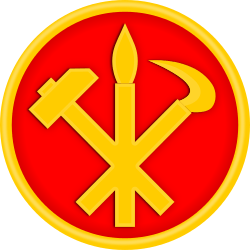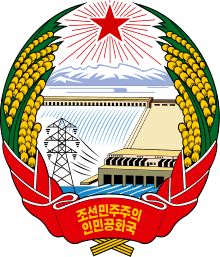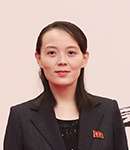Propaganda and Agitation Department
| 선전선동부 | |
 Emblem of the WPK | |
| Abbreviation | PAD |
|---|---|
| Purpose | Propaganda in North Korea |
| Headquarters | Pyongyang |
Region | North Korea |
Director | Kim Ki-nam |
Vice Director | Kim Yo-jong |
Parent organization | WPK CC Secretariat |
 |
|---|
| This article is part of a series on the politics and government of North Korea |
|
|
|
Related topics |
The Propaganda and Agitation Department (PAD, Korean: 선전선동부[1]), officially the Publicity and Information Department,[2] is a department of the Central Committee of the Workers' Party of Korea (WPK) tasked with coordinating the creation and dissemination of propaganda in North Korea. It is the highest propaganda organization in the country.
History of the department can be traced back to the Soviet Civil Administration following the division of Korea in 1945. Agitation operations by the department reached their height in the years after the Korean War.
Although nominally under the Central Committee of the WPK, the department reports directly to Supreme Leader Kim Jong-un. The department is currently under the effective guidance of its vice director Kim Yo-jong, sister of Kim Jong-un, while its nominal head is Kim Ki-nam. The department has various bureaus and offices under its control.
The department sets guidelines for all propaganda materials produced and all North Korean media is overseen by it. However, in order to maintain its clandestine nature, actions relating to repression of the media are nominally attributed to the Ministry of Culture. When newspapers are published in North Korea, they go through three rounds of censorship. The first is handled by the editors of the paper. The second and third levels are taken care of by the department.
The department also translates foreign works, if they are censored from the public, for the use of the country's political elite.[3]
Organization
.jpg)
The Propaganda and Agitation Department (PAD) is under the Secretariat of the Central Committee of the Workers' Party of Korea (WPK).[4] It is the highest propaganda organization in the country. The PAD formulates propaganda policy, controls cultural life, and produces propaganda materials.[5] It disseminates Juche, Songun, "Strong and Prosperous Nation",[6] and socialist ideologues and indoctrinates both party members and ordinary citizens with them.[5][7][8] The PAD uses both formal and informal settings to achieve these goals.[9] Because the WPK has a rich history in propaganda, the PAD is quite influential within the party structure.[5] Along with the Organization and Guidance Department, with which it cooperates,[8] it is one of the most important departments of the WPK.[5] Although nominally under the Central Committee of the WPK, the PAD reports directly to Supreme Leader Kim Jong-un.[2] The PAD's headquarters are in the center of Pyongyang.[2] The PAD is roughly analogous to the Publicity Department of the Communist Party of China.[10]
All propaganda materials are produced in accordance with guidelines set by the PAD,[11] and all media is overseen by it.[12] Limits set for content by the PAD are strict.[13] The PAD controls the press in North Korea, but in order to maintain its behind-the-scenes nature, actions relating to repression of the media are often publicly attributed to the Ministry of Culture instead.[14] When newspapers are published in North Korea, they go through three rounds of censorship. The first is handled by the editors of the paper. The second and third levels are taken care of by the PAD. Its General Bureau of Publication Guidance reviews both newspapers and other types of publications and broadcasts. The PAD's Newspaper Administration is the final level of press censorship.[15] Likewise, radio and television broadcasts and the Korean Central News Agency are also under supervision of the PAD through the Korean Central Broadcasting Committee, to which it appoints personnel; only the Voice of National Salvation is controlled by the United Front Department of the party instead.[16] The PAD cooperates with the State Security Department and Ministry of People's Security to curtail international broadcasting into North Korea.[6] The General Propaganda and Agitation Department of the Ministry of People's Armed Forces maintains a separate structure, but the PAD cooperates with it. Other partners include the Party History Institute and the Korea Documentary Film Studio.[4]
The PAD has numerous bureaus and offices under it.[6] For instance, the April 15 Literary Production company is directly under the PAD and the company often supplies the department with executives.[17][4] The Workers' Party of Korea Publishing House, Foreign Languages Publishing House, Workers' Publishing House, and Kumsong Youth Publishing House are also under its control.[4] The PAD also translates otherwise forbidden foreign works for the use of the country's political elite.[3] The Korea Film Studios and the 25 April Film Studio are under the Ministry of Culture, but the PAD controls them and their staff.[4]
History
The history of the PAD can be traced back to the Soviet Civil Administration following the division of Korea in 1945. Agitation operations by the PAD reached their height in the years after the Korean War. They included speed campaigns such as the Chollima Movement and Pyongyang Speed, labor methodologies like the Chongsan-ri Method and the Taean Work System, and the Three Revolutions Movement.[6]
Kim To-man was the chief of the PAD until his involvement with the Kapsan Faction Incident that sought to oust Kim Il-sung in 1967.[18] Kim To-man had commissioned Act of Sincerity, a film about the life of Pak Kum-chol without the approval of Kim Il-sung. In North Korean society, this was an inexcusable offense, and Kim To-man was forced to go.[19] Kim Jong-il probably helped in purging him.[20] After this and related purges the PAD shaped the societal landscape of North Korea to allow Kim Il-sung to sediment his rule and become the supreme leader of North Korea.[6]
Kim Jong-il
Kim Jong-il had entered service of the PAD in February 1966.[21] He was appointed the head of the PAD's Guidance Section of Culture and Art and Publication and Press section in September 1967 after a meeting in which Kim Il-sung criticized those who were associated with the Kapsan Faction Incident.[22][5] In 1969, Kim Jong-il was promoted the deputy chief of the entire PAD. During this time he not only designed and issued party IDs and oversaw the handling of portraits of Kim Il-sung. In practice, Kim Jong-il ran the entire department because his nominal superior Kim Kuk-tae suffered from ill health and Yang Hyong-sop, who was tasked with ideological affairs, was engaged with science and education policy instead of propaganda.[23] In September 1973, Kim Jong-il became the chief of the PAD, a position which he held until 1985.[5]
Kim Jong-il's years in the PAD were marked by his effort to become an expert in the field of propaganda,[5] as well as him developing his charisma.[24] Kim Jong-il's main contribution in the department was to devise the "monolithic ideological system", later codified as the Ten Principles for the Establishment of a Monolithic Ideological System. Kim's various efforts greatly benefited the North Korean cult of personality.[23] During this time, the film director Choe Ik-gyu, a close confidant of his, also rose in the ranks of the PAD, becoming its vice director in 1972.[25] Choe developed mass games that would evolve into the Arirang Festival,[26] the organizing of which he is still overseeing.[27] Choe fell in and out of favor repeatedly,[28] and finally resigned from the PAD for good in 2010 after being briefly its director.[29][30]
The PAD helped to create a cultural milieu in which Kim Jong-il was named his father's successor at the Sixth Congress of the Workers' Party of Korea in 1980.[6] When his succession became urgent in the 1990s, the PAD fabricated a convincing personal history for him because he lacked any true military credentials.[31] He continued to influence the daily affairs of the PAD after his succession.[4]
Kim Jong-un
Before the death of Kim Jong-il, it was already speculated that the imminent succession would have to employ the PAD.[32] Kim Jong-un's sister Kim Yo-jong became the de facto leader of PAD when she was appointed its vice director and put in charge of "idolization projects" of Kim Jong-un.[33] The nominal director is Kim Ki-nam.[2]
Leadership

- Kim To-man[23]
- Pak Chang-ok (director, 1950–1955)[34]
- Pak Yŏng-bin (director, February 1950-)[35]
- Jong Kyong-hui (deputy director, 1961-)[36]
- Choe Ik-gyu (director, 2009 – February 2010[29][30])
- Kang Nung-su (director, February 2010–[30])
- Jong Ha-chol (deputy director)[4]
- Ri Jae-il (deputy director)[4]
- Kim Ki-nam (vice director, 1966–present[37][2])
- Kim Yo-jong (vice director[37])
- Kim Jong-il[5]
- Kim Jong-nam[38]
See also
References
- ↑ Jun, Jenny; LaFoy, Scott; Sohn, Ethan (2015). North Korea's Cyber Operations: Strategy and Responses. Lanham: Rowman & Littlefield. p. 48. ISBN 978-1-4422-5903-4.
- 1 2 3 4 5 Madden, Michael (28 February 2018). "North Korea's New Propagandist?". 38 North. Retrieved 2018-03-11.
- 1 2 Jang 2015, p. 32.
- 1 2 3 4 5 6 7 8 "KWP Propaganda and Agitation Department" 2009, p. 2.
- 1 2 3 4 5 6 7 8 Lim 2015, p. 10.
- 1 2 3 4 5 6 "KWP Propaganda and Agitation Department" 2009, p. 1.
- ↑ North Korea Handbook 2002, p. 166.
- 1 2 Jieun Baek (2016). North Korea's Hidden Revolution: How the Information Underground Is Transforming a Closed Society. New Haven: Yale University Press. p. 30. ISBN 978-0-300-22447-4.
- ↑ Philo Kim (2002). "An Analysis of Religious Forms of Juche Ideology in Comparison with Christianity". International Journal of Korean Unification Studies. 11 (1): 127–144. ISSN 1229-6902.
- ↑ "KWP Propaganda and Agitation Department" (PDF). North Korea Leadership Watch. November 2009. p. 1. Retrieved 27 May 2018.
- ↑ Lim 2015, p. 11.
- ↑ Hoare, James (2012). "Media". Historical Dictionary of Democratic People's Republic of Korea. Lanham: Scarecrow Press. p. 261. ISBN 978-0-8108-6151-0.
- ↑ Jang 2015, p. 33.
- ↑ North Korea Handbook 2002, p. 170.
- ↑ North Korea Handbook 2002, p. 410.
- ↑ "KWP Propaganda and Agitation Department" 2009, pp. 1–2.
- ↑ North Korea Handbook 2002, p. 173.
- ↑ Lim 2008, pp. 43, 37.
- ↑ Lim 2008, p. 39.
- ↑ Martin 2007, pp. 353–354.
- ↑ Armstrong, Charles K. (2013). Tyranny of the Weak: North Korea and the World, 1950–1992. Ithaca: Cornell University Press. p. 321. ISBN 978-0-8014-6893-3.
- ↑ Lim 2008, pp. 39, 42–43.
- 1 2 3 Lim 2008, p. 43.
- ↑ Baek 2008, p. 218.
- ↑ North Korea Handbook 2002, p. 185.
- ↑ Fischer 2016, p. 62.
- ↑ Fischer 2016, p. 310.
- ↑ "Choe Ik-gyu" 2009, p. 1.
- 1 2 "Choe Ik-gyu" 2009, p. 2.
- 1 2 3 "Personnel Shuffles in the first half of 2010". North Korea Leadership Watch. 4 June 2010. Retrieved 19 December 2017.
- ↑ Oh, Kongdan; Hassig, Ralph C. (2004). North Korea through the Looking Glass. Washington: Brookings Institution Press. p. 89. ISBN 978-0-8157-9820-0.
- ↑ Baek 2008, p. 228.
- ↑ Lee Sang Yong (24 July 2015). "Kim Jong-un's sister promoted to run 'idolisation projects' in North Korea". The Guardian. Retrieved 28 May 2018.
- ↑ David-West, Alzo (2011). "Between Confucianism and Marxism-Leninism: Juche and the Case of Chŏng Tasan". Korean Studies. 35 (1): 93–121. doi:10.1353/ks.2011.0007. ISSN 1529-1529.
- ↑ Lankov 1999, p. 48.
- ↑ Madden 2012, p. 3.
- 1 2 Lee Sang Yong (20 July 2015). "Kim Yo Jong in de facto power of PAD". Daily NK. Retrieved 28 May 2018.
- ↑ Baek 2008, p. 224.
Works cited
- Baek Seung Joo (2008). "Prospects on characteristics of the North Korean succession system and its foreign policy in the Post-Kim Jong Il era". Korean Journal of Defense Analysis. 20 (3): 215–230. doi:10.1080/10163270802309105. ISSN 1016-3271.
- "Choe Ik-gyu" (PDF). North Korea Leadership Watch. October 2009. Retrieved 19 December 2017.
- Fischer, Paul (2016). A Kim Jong-Il Production: Kidnap, Torture, Murder... Making Movies North Korean-Style. London: Penguin Books. ISBN 978-0-241-97000-3.
- Jang Jin-sung (2015). Dear Leader: My Escape from North Korea. Translated by Shirley Lee. New York: Atria. ISBN 978-1-4767-6656-0.
- Jae-Cheon Lim (2008). Kim Jong-il's Leadership of North Korea. London: Routledge. ISBN 978-1-134-01712-6.
- — (2015). Leader Symbols and Personality Cult in North Korea: The Leader State. London: Routledge. ISBN 978-1-317-56741-7.
- "KWP Propaganda and Agitation Department" (PDF). North Korea Leadership Watch. November 2009. Retrieved 27 May 2018.
- Lankov, Andrei N. (1999). "Kim Il Sung's Campaign against the Soviet Faction in Late 1955 and the Birth of Chuch'e". Korean Studies. 23 (1): 43–67. doi:10.1353/ks.1999.0003. ISSN 1529-1529.
- Madden, Michael (2012). "Jong Kyong Hui (Chŏng Kyŏng-hŭi)". KPA Journal. 2 (11): 3–4. OCLC 741222847. Retrieved 28 May 2018.
- Martin, Bradley K. (2007). Under the Loving Care of the Fatherly Leader: North Korea and the Kim Dynasty. New York: St. Martin's Press. ISBN 978-1-4299-0699-9.
- North Korea Handbook. Seoul: Yonhap News Agency. 2002. ISBN 978-0-7656-3523-5.
Further reading
- Kim Il-sung (1973). On Eliminating Dogmatism and Formalism and Establishing Juche in Ideological Work: Speech to Party Propaganda and Agitation Workers, December 28, 1955. Pyongyang: Foreign Languages Publishing House. OCLC 1388585.
- — (1974). "On the Elimination of Formalism and Bureaucracy in Party Work and the Revolutionization of Functionaries: Speech to Functionaries of the Department of Organizational Leadership and Propaganda and Agitation, Central Committee of the Workers' Party of Korea, October 18, 1966". Selected Works. IV (2nd ed.). Pyongyang: Foreign Languages Publishing House. pp. 421–458. OCLC 184772404.
- Kim Jong-il (1987). Propaganda Officials Must Establish a Political Standard and Work Effectively: Speech at a Meeting of the Senior Officials of the Propaganda Department of the Central Committee of the Workers' Party of Korea December 15, 1987 (PDF). Pyongyang: Foreign Languages Publishing House.
- — (1992). On Breaking Outdated Patterns and Bringing about a Fresh Change in Party Work: Speech to Officials of the Organizational Leadership Department and the Propaganda and Agitation Department of the Central Committee of the Workers' Party of Korea, February 28, 1974. Pyongyang: Foreign Languages Publishing House. OCLC 622619429.